|
Summary: Sky watchers who saw
it will never forget it: the 2001 Leonid meteor storm.
The display began
on Sunday morning, Nov. 18th, when Earth glided into a dust cloud shed by comet Tempel-Tuttle in 1766. Thousands
of meteors
per hour rained over North America and Hawaii. Then, on Monday
morning Nov. 19th (local time in Asia), it happened again: Earth
entered a second cometary debris cloud from Tempel-Tuttle. Thousands
more Leonids then fell over east Asian countries and Australia.
This is Page 1 | Page 2 | Page
3 | Page 4 | Page 5 | Page
6
All images below
are copyrighted by the photographers.
Some of the videos in this collection appear in RealPlayer
format.
|
|
Photographer, Location |
Images |
Comments |
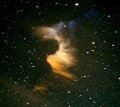 |
Jim Bryan,
Gaston, Indiana, USA
Nov. 18 |
#1 |
J. Bryan: "The Leonid [that created this
smokey debris] was very large and bright, illuminating the ground
like lightning. The debris train was about 1 minute old when
the exposure was started. Photo details: Kodak Max 400, Mamiya
Sekor 1000DTL SLR, 50mm lens @ f 1.8, one min. exp. The train
was visible for another 5 minutes before dissipating from view.
100% on the Wow Scale!" |
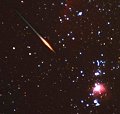 |
Mark
A. Brown, east-central Alabama, USA
Nov. 18 |
#1, #2, #3 |
Close-up
of Orion's Belt: 200mm lens @f4.5. Guided for ~3.5 minutes
using Fugi Superia 800 speed film. A
pair of Leonid meteors in Orion: 70mm lens @f3.5. Guided
for 50 seconds using Fugi 400 speed film. A
meteor: 50mm lens @f3.5. Guided for ~30 seconds using Fugi
Superia 800 film. Minolta SLR camera. |
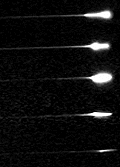 |
George Varros,
Mount Airy, MD, USA
Nov. 18 |
#1,
hi-res frames: #2,
#3, #4,
#5, #6 |
G. Varros: "This sequence of five images
captured by the Meteor
Tracker system at 07:42:25 UT on November 18, 2001, shows
the evolution of a bright Leonid fireball. The field of view
is 7 1/2 degrees. The Meteor Tracker was developed by George
Varros, and in part with Dr. Peter Jenniskens of NASA AMES and
Peter Gural of SAIC. " |
 |
Sherry Buttnor,
Metchosin, BC, Canada
Nov. 18 |
#1,
#2 |
Photo details: Kodak Max 400 film, Nikon FE camera
w/ 28mm lens, 10 minute guided exposure on a B&L Criterion
drive system. |
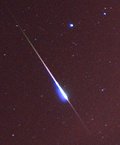 |
Ferris
Hall, North Grafton, Mass., USA
Nov. 18 |
#1, more |
The full-sized
version of this image shows a pleasing star field including
the planet Jupiter, and the constellations Orion and Gemini.
Photo details: Exposure: 30 seconds, f2.8, 800 ISO, +5.0 push.
16mm fish eye. Nikon D1x. ~3am. |
 |
Kevin Alber,
Battleground, Washington, USA
Nov. 18 |
#1 |
Bruce, Erik, and K. Alber: "This is the
ionized train left by a very bright Leonid meteor, estimated
magnitude -8 which appeared at 3:05 am PST. The photo was taken
about 2 minutes after it passed over, and the train was visible
for at least another 30 minutes!" Photo details: ASA 400
Kodak Max film, 45 seconds, F1.4 |
 |
John
Welsh, Valley Forge National Park, PA, USA
Nov. 18 |
#1, more |
Even the bright headlines of oncoming cars couldn't
outshine this bright Leonid meteor. Photo details: Fuji 400 color
neg film, 17mm Nikkor lens, F2.8, exp. 2 minutes |
 |
Lesleyanne
Ryan, St. Philips, Newfoundland,
Canada
Nov. 18 |
#1 |
L. Ryan: "I used my old Minolta XGA with
400 film - exposure of about 10
seconds on f2. We had an excellent display of at least a dozen
bright
meteors a minute." |
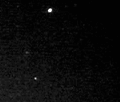 |
George Varros,
Mount Airy, MD, USA
Nov. 17 |
#1,
#2 (Real Player) |
G. Varros: "This fireball appeared at 08:50
UT on Nov. 17, 2001. The field of view is 75 degrees using a
Gen II image intensified camera coupled to a PC-23-C video camera.
Jupiter is at the top of this image." |
 |
Collin Orthner,
near Red Deer, Alberta, Canada
Nov. 18 |
#1,
#2 |
Photo details: Canon G2; 15 sec exposure at f/2;
34mm focal length. |
 |
John Carlson,
near Mayer, Minnesota, USA
Nov. 18 |
#1,
#2 |
J. Carlson: "An awesome display. Several
meteors created a visible flash and then left a glow that remained
visible for up to 30 seconds." Photo details: Camera: Nikon
CoolPix 995; Exposure: 8 Seconds at F/2.6 |
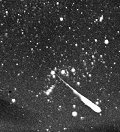 |
Juraj
Toth, Astronomical Observatory
Modra, Slovakia
Nov. 15 |
#1, more |
J. Toth: "This picture of a Leonid in Orion
is a part of an all-sky image recorded at the Astronomical Observatory
Modra, Slovakia. The exposure begun at 2:01:50 UT and ended at
4:43:00 UT on November 15, 2001. Photo details: Fomapan 100 B&W film,
Zeiss Distagon (fish-eye) objective 3.5/30 mm." |
 |
Anthony Lee,
Lantau Island, Hong Kong, China
Nov. 19 |
#1, #2 |
A. Lee and friends from the Sky Observers Association:
"Although light pollution is a problem in Hong Kong, my
friends and I really enjoyed the show. We watched thousands of
meteors from 00:00 to 05:30. Unforgettable!" Photo details:
Ricoh GR1s, 28mm, f/2.8, film: Kodak Professional Supra 800 |
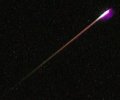 |
Chris
and Teresa Anderson, Kentucky, USA
Nov. 18 |
#1,
more |
A very bright Leonid in Ursa Major. Sixteen second
exposure at f1.8, Olympus C3040 digital camera. |
 |
Schindler
Leung, Plover Cove Reservoir, Hong Kong, China
Nov. 17 |
#1 |
In the full-sized
version of this image a 0th magnitude Leonid meteor appears
just between Ursa Minor and Draco. Photo details: Date: 2001/11/16;
Local time: 20:33:37; Exposure: 17 s; F 2.8; Fujinon 28 mm; Fuji
Superior X-tra 400. |
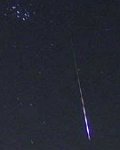 |
Ricky Steele,
near, Oklahoma City, OK, USA
Nov. 18 |
#1 |
R. Steele: "I took this picture of a Leonid
near the Pleiades using a Sony 5 Megapixel DSC707 digital camera
(30 second exposure). I live about 30 miles from Oklahoma City
and we enjoyed a great show from 2:45 - 6:00 AM this morning!" |
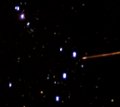 |
Chip Griffin,
Columbus, GA, USA
Nov. 18 |
#1,
#2 |
A larger
version of #1 reveals a pair of Leonid meteors (one bright
and one faint) slicing through the constellation Orion. Photo
details: Nikon digital with 50mm lens at f1.4 for 15s |
 |
Gary Sumner,
Nevada City, CA, USA
Nov. 18 |
#1,
#2 |
G. Sumner: "#2
shows the trail of a fireball about 6 min. after it was gone,
with the wind twisting it. (I just wish I had remembered to focus
my camera!) Both shots were taken with a Canon AE1 and a 28 mm
lens for 30 sec. at f2.8." |
More images (click on the name of the photographer
to view the image):
Andrew J. Smith (Albany,
NY); Gary D. Smith (Norwich,
NY)
back
to spaceweather.com |

















